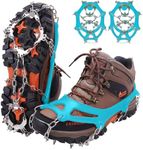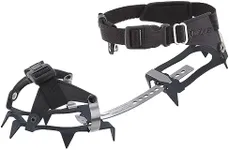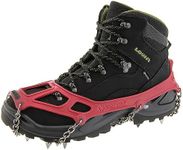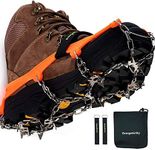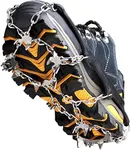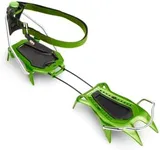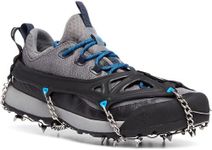Buying Guide for the Best Snow Spikes
When it comes to buying snow spikes, it's essential to consider various factors to ensure you get the right product for your needs. Snow spikes, also known as ice cleats or crampons, are designed to provide traction on icy and snowy surfaces, making them crucial for safety during winter activities. Here are some key specifications to consider when choosing snow spikes and how to navigate them to find the best fit for you.Type of SpikesThe type of spikes refers to the design and material of the spikes themselves. This is important because different types of spikes offer varying levels of traction and durability. Generally, there are microspikes, which are small and lightweight, suitable for light hiking and running; crampons, which are more robust and designed for mountaineering and ice climbing; and hybrid spikes, which offer a balance between the two. Choose microspikes for casual use, crampons for extreme conditions, and hybrids for versatile use.
MaterialThe material of the snow spikes affects their durability and performance. Common materials include stainless steel, aluminum, and rubber. Stainless steel spikes are highly durable and resistant to rust, making them ideal for frequent use in harsh conditions. Aluminum spikes are lighter but less durable, suitable for occasional use. Rubber components provide flexibility and comfort. Consider stainless steel for heavy-duty use, aluminum for lightweight needs, and rubber for comfort.
Attachment SystemThe attachment system refers to how the snow spikes secure to your footwear. This is crucial for ensuring a snug fit and preventing the spikes from slipping off. Common systems include strap-on, step-in, and hybrid. Strap-on systems are versatile and fit most footwear, step-in systems offer quick and secure attachment but require compatible boots, and hybrid systems combine features of both. Choose strap-on for versatility, step-in for convenience with compatible boots, and hybrid for a balance of both.
Number of SpikesThe number of spikes determines the level of traction provided. More spikes generally mean better grip on icy surfaces. Light-duty spikes may have around 6-10 spikes, suitable for casual walking and running. Medium-duty spikes have 10-14 spikes, ideal for hiking and moderate trails. Heavy-duty spikes with 14 or more spikes are designed for mountaineering and extreme conditions. Choose the number of spikes based on the intensity of your activities.
WeightThe weight of the snow spikes can affect your comfort and mobility. Lighter spikes are easier to carry and less tiring to wear, making them suitable for running and light hiking. Heavier spikes provide more stability and durability, ideal for mountaineering and extended use. Consider lighter spikes for activities requiring agility and heavier spikes for stability in challenging conditions.
Size and FitSize and fit are crucial for comfort and effectiveness. Snow spikes come in various sizes to fit different footwear. It's important to choose a size that matches your shoe size and type. Some models offer adjustable features to ensure a secure fit. Ensure the spikes fit snugly without being too tight or loose to prevent discomfort and ensure safety. Measure your footwear and check the manufacturer's sizing guide to find the right fit.

